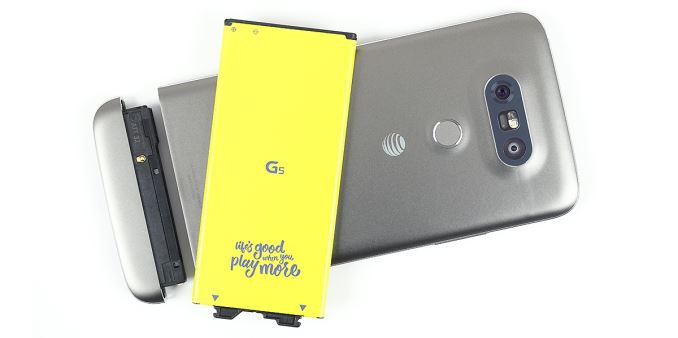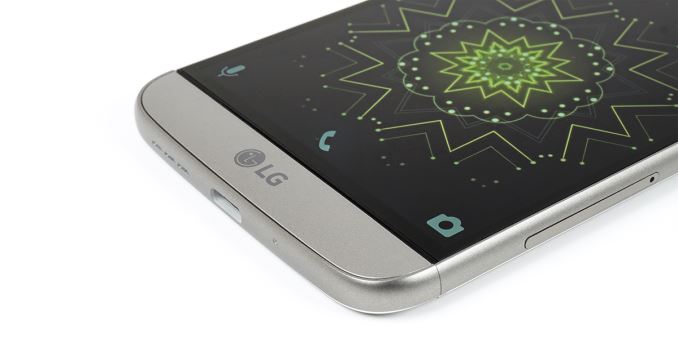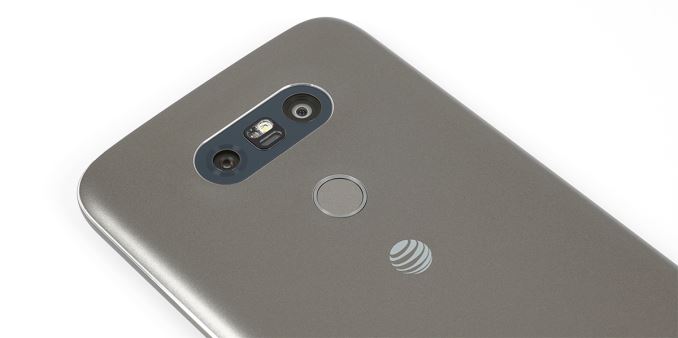The LG G5 Review
by Matt Humrick on May 26, 2016 8:00 AM EST- Posted in
- Smartphones
- Snapdragon
- Qualcomm
- LG
- Mobile
- Snapdragon 820
- LG G5

While Samsung took its Galaxy lineup in a new direction last year, LG moved its G Series along a well-traveled road. The LG G4 retained the same design language and features as the G3, and its upgraded cameras and new wide-gamut display were not enough to keep it from falling further behind other flagship devices. The G4 eventually veered into the upper mid-range lane, allowing LG’s more luxurious V10 to pass by in the flagship express lane.
The G4’s SoC was one of the components that limited its peak performance. After LG saw demand for its G Flex2 melt away after reports of overheating, it switched from using Qualcomm’s octa-core 810 SoC to the hexa-core Snapdragon 808 for the G4, which was at least less prone to thermal throttling; however, it failed to give the G4 a significant edge in performance or battery life over its predecessor.
Tired of moving along at a slower pace, LG decided to overhaul its G Series. The new G5 receives an aluminum body with a fresh coat of paint and the Snapdragon 820 SoC. Built around four of Qualcomm’s custom-designed 64-bit Kryo CPU cores and a new Adreno 530 GPU, the 820 provides a performance boost over previous Snapdragon SoCs in specific workloads and is proving to be a popular choice for current generation phones.
Like Samsung’s Galaxy S7, the G5 comes with 4GB of LPDDR4 RAM and 32GB of UFS 2.0 NAND. LG does not offer any SKUs with more internal storage, so using the microSD slot is the only way to increase capacity. The G5 also adopts the new, reversible USB Type-C port (but only supports USB 2.0 transfer rates) and adds a second spatial stream to the 802.11ac Wi-Fi, elevating maximum theoretical bandwidth to 867Mb/s.
| LG G Series | ||
| LG G5 | LG G4 | |
| SoC | Qualcomm Snapdragon 820 (MSM8996) 2x Kryo @ 2.15GHz 2x Kryo @ 1.59GHz Adreno 530 @ 624MHz |
Qualcomm Snapdragon 808 (MSM8992) 4x Cortex-A53 @ 1.44GHz 2x Cortex-A57 @ 1.82GHz Adreno 418 @ 600MHz |
| RAM | 4GB LPDDR4-3188 | 3GB LPDDR3-1866 |
| NAND | 32GB (UFS 2.0) + microSD |
32GB (eMMC 5.0) + microSD |
| Display | 5.3-inch 2560x1440 IPS LCD | 5.5-inch 2560x1440 IPS LCD |
| Dimensions | 149.4 x 73.9 x 7.7 mm 159 grams |
148.9 x 76.1 x 6.3 - 9.8 mm 155 grams |
| Modem | Qualcomm X12 (Integrated) 2G / 3G / 4G LTE (Category 12/13) |
Qualcomm X10 (Integrated) 2G / 3G / 4G LTE (Category 6/9) |
| SIM Size | NanoSIM | MicroSIM |
| Front Camera | 8MP, 1/4" Toshiba T4KA3, 1.12µm pixels, f/2.0, HDR, screen flash | 8MP, 1/4" Toshiba T4KA3, 1.12µm pixels, f/2.0, HDR, screen flash |
| Rear Camera | Primary: 16MP, 1/2.6" Sony IMX234 Exmor RS, 1.12µm pixels, f/1.8, Laser AF, 3-axis OIS, HDR, color spectrum sensor, LED flash | 16MP, 1/2.6" Sony IMX234 Exmor RS, 1.12µm pixels, f/1.8, Laser AF, 3-axis OIS, HDR, color spectrum sensor, LED flash |
| Wide Angle: 8MP, Sony IMX268 Exmor RS, 1.12µm pixels (assumed), f/2.4, wide-angle (135°), Laser AF, OIS, HDR, color spectrum sensor, LED flash | ||
| Battery | 2800 mAh (10.78 Wh) replaceable |
3000 mAh (11.55 Wh) replaceable |
| Connectivity | 802.11a/b/g/n/ac 2x2 MIMO, BT 4.2, NFC, IrLED, GPS/GNSS, SlimPort, DLNA, USB 2.0 Type-C, LG Modular Port | 802.11a/b/g/n/ac, BT 4.1, NFC, IrLED, GPS/GNSS, SlimPort, DLNA, microUSB 2.0 |
| Launch OS | Android 6.0.1 with LGUX 5.0 | Android 5.1 with LGUX 4.0 |
| Launch Price (No Contract) |
~630 USD retail (US) | ~649 USD retail (US) |
The G4’s 8MP front-facing camera carries over to the G5, as does the 16MP Sony IMX234 rear camera, which resides in an upgraded module developed by LG Innotek. Sitting next to the 16MP primary rear camera, however, is a second 8MP camera with a wide-angle lens. Its 135° horizontal field of view—compared to 78° for the primary camera—allows you to capture more of your surroundings in each image, useful in large, open spaces or when taking group photos. There are drawbacks to using a wide-angle lens, though, which we’ll cover more in-depth later when we evaluate camera performance.
The G5 also gains an always-on display feature similar to the Galaxy S7. LG first explored this idea with last year’s V10, adding a small second screen above the large main screen. The G5’s implementation is more conventional, doing away with the second screen and keeping only a subset of the V10’s functionality. It shows the time centered near the top of the screen with the date below in a smaller font when the phone is asleep. Notifications show up as small icons below the date, informing you about new email or text messages without revealing any sensitive information. There’s also an option to replace the time with a customized static message roughly twelve characters in length, which just seems silly.
An always-on display feature makes a lot of sense when using an OLED panel that only needs to power the few pixels actually in use. The G5 uses an LCD panel, however, which needs to power the backlight whether it’s showing a single pixel or all of them. To reduce power consumption, LG is using a new LED driver IC that divides the backlight into two separate zones that can be powered on independently. Thus, only about the top one-third of the display is active when using the always-on feature. The G5’s display also supports panel self-refresh, which helps save power when the screen’s content is static. Based on LG’s power figures, the always-on display should drain the battery by about 10% over a 12 hour period, which could be less than the amount used if you’re constantly turning the display on to check the time or for new notifications. The G5 also uses the ambient light sensor to turn off the display when it senses it’s in a pocket or purse or even when lying face down. The feature can also be disabled in the settings menu.
It seems like every smartphone has a fingerprint sensor nowadays, and the G5 is no exception. Integrated into the power button on the back of the phone, the new circular, touch-based sensor wakes up and unlocks the phone with a single press. Like other capacitive sensors, it does not handle moisture or changes in temperature well. I also experienced a higher rejection rate initially with the G5 than I did with the Nexus 6P because my finger did not always land on the sensor the same way. Registering the same finger in a few different positions improved performance, but the G5’s experience was never as seamless or quick as some of the other devices I’ve used, including the 6P, iPhone 6s Plus, and Galaxy S7. On several occasions I had to punch in my pin code after locking out the fingerprint sensor with five failed attempts.












92 Comments
View All Comments
zeeBomb - Sunday, May 29, 2016 - link
This...a million times this. When the G4 introduced Quantum Dot display...I hoped for LG to embark a good feat in innovation. Fast forward to now, LG releases a display we can't even utilize, and is somewhat power hungry? Goodness sake. I think even because of this I moved away from the LG G5 and lost interest in LG devices entirely.Blairdrafting - Friday, May 27, 2016 - link
My problem with the G5 is the erratic antenna signal .... it bounced from 1 to 4 bars even with phone on table right in front of tower... I went to the S7. Same phone just better signalflyingfiddle - Friday, May 27, 2016 - link
Anyone noticing the LG is getting worse and worse on Screen to Body ratio with their flagship phones? (Data from phonearena) G2 76.3%, G3 75.2%, G4 72.5%, and G5 70.2%!! What has LG's designers been smoking? Now with G5 all of sudden proven 5.5 inch screen is too large that they can only fit a 5.3 inch?They have something really unique going for it (removable battery and SD expansion), but they always manage to negate those in some other ways. G3 actually was the best LG I consider, design wise. Unfortunately its construction wasn't great. I recently installed Fulmics 5.2 custom rom (MM based) onto G2 and it flies as fast as G4. G4 was much sturdier, much better constructed, love the leather back, but larger and less economical. Reviewer always say G5 design is a huge departure but if you look at the front the G3 and G5, they are actually very similar. So I don't understand why LG has the shrink the G5's screen so much to fit to that body.
I was super excited watching their launch event but was more and more disappointing after reading review after review and after handling it in-store in person. Just wish my Canadian G4 has unlockable bootloader to allow some decent custom ROM development.
Klug4Pres - Saturday, May 28, 2016 - link
Yes. I am still using a G3, which I find to be a decent size and weight for the size of its screen.I actually think height is the limiting factor for me, and there is always a fair bit of height not covered with screen. Some is needed obviously.
zeeBomb - Sunday, May 29, 2016 - link
Unlockable Bootloader eh... What carrier are you with and which ROM?tuxRoller - Saturday, May 28, 2016 - link
Would you please look into measuring touch latency, please?This is something that no English reviewer seems to be doing even though it is such an integral part of a user's experience.
sireangelus - Saturday, May 28, 2016 - link
Is it just me or the 5x on the benches looks incredibly competitive even in comparison to an s7?refillable - Sunday, May 29, 2016 - link
Sigh... No Offense, but stick to reviewing PC hardware. Just never do these again.Tech_guy - Sunday, May 29, 2016 - link
Why is Snapdragon 820 web performance so horrible versus last years iPhone 6s plus?SydneyBlue120d - Thursday, June 2, 2016 - link
We are at the second generation of SOC with builtin HEVC encoding, and still no signs of any way to use it, do You think we will ever see a smartphone with HEVC encoding enabled? Thanks a lot.